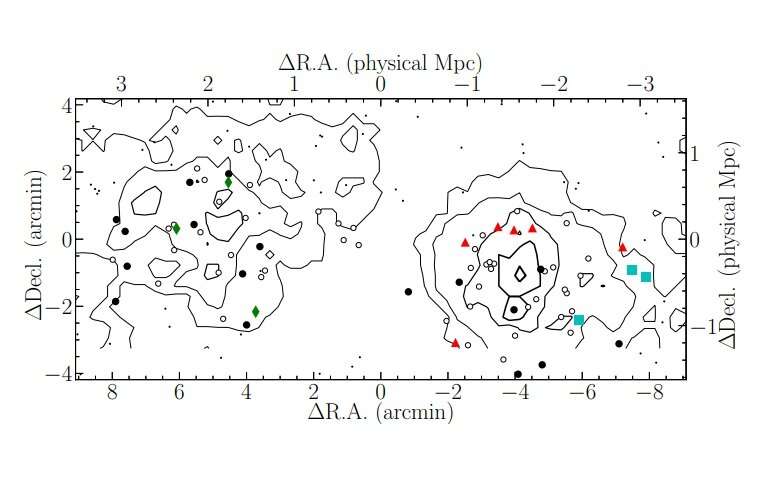December 13, 2019 report
Astronomers discover two new galaxy protoclusters

Using Keck Observatory in Hawaii, astronomers have detected two new protoclusters of galaxies embedded in primordial superclusters. The research paper presenting the discovery and providing basic information about the newfound objects was published December 3 on the arXiv pre-print repository.
Galaxy clusters contain up to thousands of galaxies bound together by gravity. They are the largest known gravitationally bound structures in the universe, and could serve as excellent laboratories for studying galaxy evolution and cosmology.
Astronomers are especially interested in finding protoclusters of galaxies, the progenitors of clusters. Such objects, found at high redshifts, could provide essential information about the universe at its early stages. However, detecting these structures at high redshifts (above 2.0) is challenging, requiring deep, wide-area surveys for proper identification.
Now, a team of researchers led by Jun Toshikawa of the University of Tokyo, Japan, reports two new high-redshift protoclusters of galaxies. The discovery was made as a result of follow-up observations of three over-dense regions of galaxies designated D1RD01, D1GD02, and D4GD01, first identified by the Canada-France-Hawaii Telescope Legacy Survey (CFHTLS) Deep Fields program. For this purpose, the researchers employed the DEep Imaging Multi-Object Spectrograph of the Keck II telescope.
"In this study, we have presented optical follow-up spectroscopy on the three over-dense regions of g- and r-dropout galaxies in the CFHTLS Deep Fields," the astronomers wrote in the paper.
As a result, the follow-up observing campaign found two protoclusters at redshifts of approximately 4.9 in the region D1RD01 and 3.72 in D4GD01, and identified one possible protocluster D1GD02 at a redshift of about 3.83.
According to the study, the D1RD01 protocluster consists of at least six member galaxies, while the one in D4GD01 was observed to contain nine galaxies. The number of member galaxies in the candidate protocluster in D1GD02 is yet to be determined.
Furthermore, the research found two small galaxy groups (each including three galaxies) in the vicinity of the D1RD01 protocluster. The astronomers expect these two groups to become a part of a supercluster rather than merge into the protocluster to form a single massive dark matter halo. A similar situation was found in the other two studied regions.
"Similarly, in the over-dense regions of both D1GD02 and D4GD01, we have found close pair-like structures whose redshift separation is only ∆z ∼ 0.05. These results suggest that large-scale galaxy/group assembly comparable to the size of superclusters start by z > 4, and the primordial satellite components of superclusters appear at z ∼ 4−5 in parallel with the formation of central protoclusters," the paper reads.
Summing up the results, the astronomers noted that their study supports the hypothesis that the formation of a supercluster starts in the early universe, and that the main and background protoclusters at a redshift of about 3.7 show different galaxy distributions. However, further multi-wavelength observations of more protoclusters are needed to confirm this.
More information: Discovery of Protoclusters at z ∼ 3.7 & 4.9: Embedded in Primordial Superclusters, arXiv:1912.01625 [astro-ph.GA] arxiv.org/abs/1912.01625
© 2019 Science X Network




















